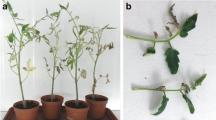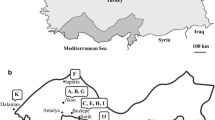Abstract
Sixty-eight Clavibacter michiganensis subsp. michiganensis (Cmm) strains from recent outbreaks of bacterial wilt and canker in Serbia were collected from several tomato growing regions during a three-year period. The pathogen was identified based on bacteriological characteristics and pathogenicity tests and the identity of strains was confirmed by DAS ELISA and PCR amplification using primers CMM5/6 and PSA4/R. The strains showed homogeneity in biochemical and physiological properties. However, pathogenicity tests revealed differences in virulence that are presumably due to a loss of the pat-1 gene. Further strain characterization using DNA-based methods revealed a high diversity of the Serbian Cmm strains. Based on multi-locus sequence typing (MLST) analyses of five genes, Cmm strains were divided into seven groups. The pulsed-field gel electrophoresis (PFGE) pattern of a selection of strains supported the groupings based on trees of the kdpA/sdhA sequences. On the other hand, groupings made according to PFGE and MLST were not correlated to plasmid content in all cases. This study suggested that high genetic variability of the Serbian Cmm strains was detected both in MLST and PFGE analyses, and could have resulted either from new Cmm strains being introduced by seeds from different origins or as a consequence of an intraspecific hybridization process. In addition, this study proposed MLST as an efficient tool in epidemiological studies, population biology investigations and tracking the routes of transmission of pathogens. Four of the five house-keeping genes (kdpA, sdhA, ligA and gyrB) selected to characterize Cmm strains proved to be suitable for the MLST analysis. This is the first study carried out on the characterization of Cmm using MLST.






Similar content being viewed by others
Abbreviations
- Cmm :
-
Clavibacter michiganensis subsp. michiganensis
- DAS ELISA:
-
Double Antibody Sandwich ELISA
- MLST:
-
Multi-locus sequence typing
- NJ:
-
Neighbor joining
- PFGE:
-
Pulsed-field gel electrophoresis
References
Almeida, N. F., Yan, S., Cai, R., Clarke, C. R., Morris, C. E., et al. (2010). PamDB, a multilocus sequence typing and analysis database and website for plant-associated microbes. Phytopathology, 100, 208–215.
Anonymous. (2005). Clavibacter michiganensis subsp. michiganensis. PM 7/42. Bull. OEPP/EPPO Bulletin, 35, 275–283.
Baysal, O., Mercati, F., Ikten, H., Yildiz, R. C., Carimi, F., Aysan, Y., & Teixeira da Silva, J. (2011). Clavibacter michiganensis subsp. michiganensis: Tracking strains using their genetic differentiations by ISSR markers in Southern Turkey. Physiological and Molecular Plant Pathology, 75, 113–119.
Bentley, S. D., Corton, C., Brown, S. E., Barron, A., Clark, L., et al. (2008). Genome of the actinomycete plant pathogen Clavibacter michiganensis subsp. sepedonicus suggests recent niche adaptation. Journal of Bacteriology, 190, 2150–2160.
Carlton, W. M., Braun, E. J., & Gleason, M. L. (1998). Ingress of Clavibacter michiganensis subsp. michiganensis in to tomato leaves through hydatodes. Phytopathology, 88, 525–529.
Chang, R. J., Ries, S. M., & Pataky, J. K. (1992). Reduction in yield of processing tomatoes and incidence of bacterial canker. Plant Disease, 76, 805–809.
Clark, M. F., & Adams, A. N. (1977). Characterization of the microplate method of enzyme linked immunosorbent assay for detection of plant viruses. Journal of General Virology, 34, 475–483.
de Leon, L., Rodriguez, A., Llop, P., Lopez, M. M., & Siverio, F. (2009). Comparative study of genetic diversity of Clavibacter michiganensis subsp. michiganensis isolates from the Canary Islands by RAPD-PCR, BOX-PCR and AFLP. Plant Pathology, 58, 862–871.
de Leon, L., Siverio, F., Lopez, M. M., & Rodriguez, A. (2011). Clavibacter michiganensis subsp. michiganensis, a seedborne tomato pathogen: Healthy seeds are still the goal. Plant Disease, 95, 1328–1338.
Dreier, J., Bermpohl, A., & Eichenlaub, R. (1995). Southern hybridization and PCR for specific detection of phytopathogenic Clavibacter michiganensis subsp. michiganensis. Phytopathology, 85, 462–468.
Gartemann, K.-H., Abt, B., Bekel, T., Burger, A., Engemann, J., et al. (2008). The genome sequence of the tomato-pathogenic actinomycete Clavibacter michiganensis subsp. michiganensis NCPPB382 reveals a large island involved in pathogenicity. Journal of Bacteriology, 190, 2138–2149.
Gitaitis, R. D. (1990). Induction of a hypersensitive like reaction in four-o’clock by Clavibacter michiganensis subsp. michiganensis. Plant Disease, 74, 58–60.
Gitaitis, R. D., Beaver, R., & Voloudakis, A. (1991). Detection of Clavibacter michiganensis subsp. michiganensis in symptomless tomato transplants. Plant Disease, 75, 834–838.
Gleason, M. L., Gitaitis, R. D., & Ricker, M. D. (1993). Recent progress in understanding and controlling bacterial canker of tomato in eastern North America. Plant Disease, 77, 1069–1076.
Hadas, R., Kritzman, G., Klietman, F., Gefen, T., & Manulis, S. (2005). Comparison of extraction procedures and determination of the detection treshold for Clavibacter michiganensis subsp. michiganensis in tomato seeds. Plant Pathology, 54, 643–649.
Kaneshiro, W. S., Mizumoto, C. Y., & Alvarez, A. M. (2006). Differentiation of Clavibacter michiganensis subsp michiganensis from seed-borne saprophytes using ELISA, Biolog and 16 S rDNA sequencing. European Journal of Plant Pathology, 116, 45–56.
Kawaguchi, A., Tanina, K., & Inoue, K. (2010). Molecular typing and spread of Clavibacter michiganensis subsp. michiganensis in greenhouses in Japan. Plant Patholology, 59, 76–83.
Kleitman, F., Barash, I., Burger, A., Iraki, N., Falah, Y., Sessa, G., Weinthal, D., Chalupowicz, L., Gartemann, K.-H., Eichenlaub, R., & Manulis-Sasson, S. (2008). Characterization of a Clavibacter michiganensis subsp. michiganensis population in Israel. European Journal of Plant Pathology, 121, 463–475.
Lelliott, R. A., & Stead, D. E. (1987). Methods for the diagnosis of bacterial diseases of plants. Oxford: Blackwell Scientific Publications.
Maiden, M. C. (2006). Multi locus sequence typing of bacteria. Annual Reviews of Microbiology, 60, 561–588.
Meletzus, D., Bermpohl, A., Dreier, J., & Eichenlaub, R. (1993). Evidence for plasmid-encoded virulence factors in the phytopathogenic bacterium Clavibacter michiganensis subsp. michiganensis. Journal of Bacteriology, 175, 2131–2136.
Milijašević, S., Todorović, B., & Balaž, J. (2006). Clavibacter michiganensis subsp. michiganensis, bacterial canker of tomato: 1. Conventional and molecular identification. Pesticides and Phytomedicine, 21, 185–192.
Milijašević, S., Todorović, B., Rekanović, E., & Stepanović, M. (2009). Occurrence of bacterial canker of tomatoes in Southern Serbia. (Paper presented at the Second International Symposium on Tomato Diseases, Kusadasi,Turkey, pp 307–311).
Mortensen, C. N. (1999). Seed-borne Bacterial Diseases. Danish Government Institute of Seed Pathology for Developing Countries, Hellrup, Copenhagen, Denmark, pp. 86–92.
Pastrik, K. H., & Rainey, F. A. (1999). Identification and differentiation of Clavibacter michiganensis subspecies by Polymerase Chain Reaction-based techniques. Journal of Phytopathology, 147, 687–693.
Ramos-Gonzalez, M.-I., Duque, E., & Ramos, J. L. (1991). Conjugational transfer of recombinant DNA in cultures and in soils: host range of Pseudomonas putida TOL plasmids. Applied and Environmental Microbiology, 57, 3020–3027.
Redenbach, M., Scheel, J., & Schmidt, U. (2000). Chromosome topology and genome size of selected actinomycetes species. Antonie van Leeuwenhoek, 78, 227–235.
Schaad, N., Jones, J. B., & Chun, W. (2001). Laboratory guide for identification of plant pathogenic bacteria. St. Paul, Minnesota, USA: APS Press.
Stork, I., Gartemann, K.-H., Burger, A., & Eichenlaub, R. (2008). A family of serine proteases of Clavibacter michiganensis subsp. michiganensis: chpC plays a role in colonization of the host plant tomato. Molecular Plant Pathology, 9, 599–608.
Strider, D. L. (1969). Bacterial canker of tomato caused by Corynebacterium michiganense: a literature review and bibliography. North Carolina Agricultural Experiment Station Technical Bulletin 193
Šutić, D. (1957). Bakterioze crvenog patlidžana. Institut za zaštitu bilja, Beograd. Posebna izdanja, doktorska disertacija, 1–67.
Thompson, J. D., Gibson, T. J., Plewniak, F., Jeanmougin, F., & Higgins, D. G. (1997). The ClustalX windows interface: flexible strategies for multiple sequence alignment aided by quality analysis tools. Nucleic Acids Research, 24, 4876–4882.
Tsiantos, J. (1987). Transmission of Corynebacterium michiganense pv. michiganense by seeds. Journal of Phytopathology, 119, 142–146.
Werner, N. A., Fulbright, D. W., Podolsky, R., Bell, J., & Hausbeck, M. K. (2002). Limiting populations and spread of Clavibacter michiganensis subsp. michiganensis on seedling tomatoes in the greenhouse. Plant Disease, 86, 535–542.
Acknowlegdements
This research was carried out as a collaboration of the Faculty of Biology, University of Bielefeld, Germany, Department of Genetechnology/Microbiology and the Institute of Pesticides and Environmental Protection, Belgrade, Serbia, Department of Plant Pathology. A segment of this study was conducted as a part of the Project TR 34043, which is financially supported by the Ministry of Education and Science of the Republic of Serbia. The sequencing of the PCR products was conducted by IIT Biotech GmbH (Bielefeld, Germany).
Author information
Authors and Affiliations
Corresponding author
Electronic supplementary material
Below is the link to the electronic supplementary material.
Supplementary Fig. 1
Alignment of the 693-bp kdpA amplicons. (PDF 72 kb)
Supplementary Fig. 2
Alignment of 700 bp of overlapping sequence from the sdhA amplicons (PDF 75 kb)
Supplementary Fig. 3
Alignment of the 606-bp gyrB PCR products. (PDF 69 kb)
Supplementary Fig. 4
Alignment of the 544-bp ligA PCR products. (PDF 69 kb)
Supplementary Fig. 5
Alignment of the 529-bp tomA PCR products. (PDF 69 kb)
Rights and permissions
About this article
Cite this article
Milijašević-Marčić, S., Gartemann, KH., Frohwitter, J. et al. Characterization of Clavibacter michiganensis subsp. michiganensis strains from recent outbreaks of bacterial wilt and canker in Serbia. Eur J Plant Pathol 134, 697–711 (2012). https://doi.org/10.1007/s10658-012-0046-x
Accepted:
Published:
Issue Date:
DOI: https://doi.org/10.1007/s10658-012-0046-x




